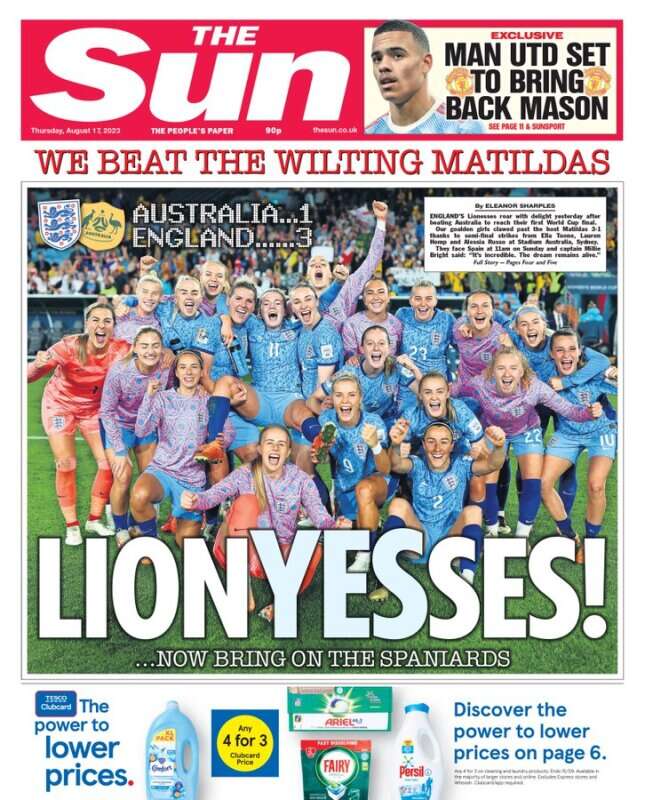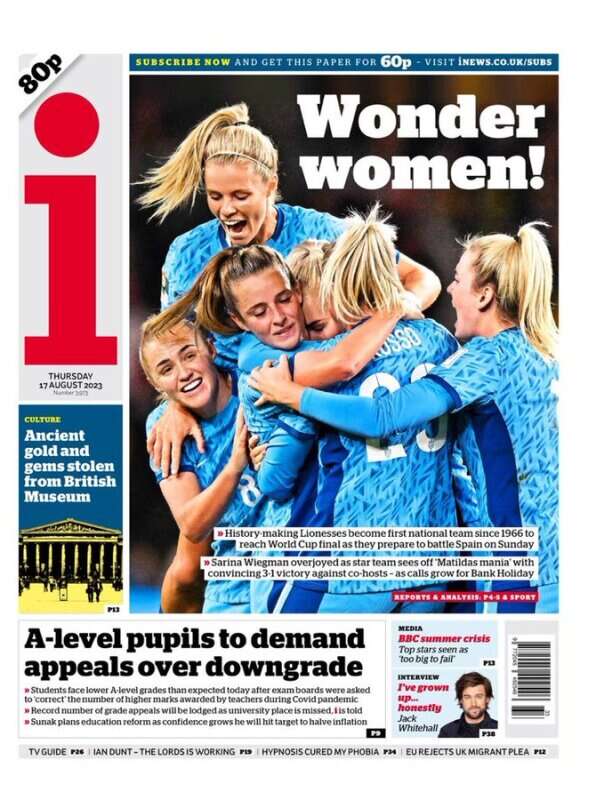
Women’s World Cup coverage has “sparkled almost as much as the Lionesses” for news publishers, who have ramped up what they are producing this year in response to growing audience interest in the sport.
It comes a month after an Enders Analysis report said that the number of articles on women’s sport, and the print page space devoted to them and prominence given to them online, has “skyrocketed” in the past two years.
Scroll down for World Cup stats from Mail Online, The Guardian, Footballco, The Telegraph and the BBC
The report said: “Every aspect of coverage is improving, unlike in men’s sport, which has reached saturation.”
It added: “The evident consumer interest in women’s sport will not cannibalise the interest or space devoted to men’s—different publications operate independently, and if anything, the potential to grab readership is an opportunity, not a hindrance.”
However, publishers were urged to position women’s sport “as an equal counterpart, not a supplement. This can be done either by giving both men’s and women’s sport fully separate sections, without a ‘standard’ homepage of (inevitably) men’s sport highlights, or by fully removing the distinction and fronting sports sections equally with women’s and men’s sport.
“The latter is preferable but more difficult to achieve, with inherent or unwitting bias from not only editorial staff but also readers, whose interest levels play a role in the assembly and representation of coverage. While a separate women’s sport section (at least in the near term) precludes full integration, it gives women’s sport space to flourish.”
The Telegraph launched a dedicated women’s sport section in 2019 and Enders said the publisher had shown a separate section is “proven to work: comments on The Telegraph Women’s Sport are 50% higher than The Telegraph’s channel average”.
‘Popular’ vs ‘quality’ newspaper coverage of women’s sport
The research showed so-called “quality” newsbrands (The Telegraph, The Times, The Guardian, BBC Sport and Sky Sports) are ahead of “popular” brands (the Mirror, Sun, Mail and Express) but the latter are “catching up fast”.
In 2022 women’s sport articles took up 35% of space for sport in quality print titles, compared to 25% for popular brands – both hugely up compared to 2019 when they represented 7% and 1% respectively.

The highest proportion of online sports articles centred on women’s sport in 2022 was at BBC Sport followed by The Guardian. The Telegraph was top in 2021, but dipped the following year.

In the period analysed last year, covering Wimbledon, the Women’s Euros and the Commonwealth Games, the BBC was the only website to have more than half its total articles cover women’s sport on any days (on 26 and 27 July 2022).
But the report concluded “this is set to change in the next two to five years as women’s sport continues to seize on present momentum; outlets resisting the shift are liable to be left behind”.
On Thursday, the morning after the semi-final, England’s win dominated the newspaper front and back pages (scroll down). But prominent coverage began well before that, with many publishers seeing record figures for women’s sport:
Mail Online: ‘Huge numbers of digital traffic’
Mail Online produced 83 stories on the Women’s World Cup on Wednesday, the day of the England-Australia semi-final, driving more than 4.5 million page views. Overall (as of Thursday afternoon) it has published more than 560 articles globally on women’s football over the World Cup, including 406 in the UK.
Its content is being produced by the sport, news, video, showbiz, Femail, business and lifestyle teams in London, Sydney and New York with ten members of staff dedicated to the World Cup in the Australia office alone.
Mail Online’s women’s football correspondent Kathryn Batte and Ian Herbert, last year’s Sports Journalism winner at the British Journalism Awards, have been reporting from the ground in Australia while columnists writing about the tournament include ex-Lionesses Ellen White and Steph Houghton.
On the day of England’s semi-final win, Mail Online saw 18% more article views on its sport channel compared to the average Wednesday in the UK compared to the last 120 days. Globally, it saw a 23% uplift.
The publisher also highlighted that it has received more than 3.5 million views on its Tiktok channels to World Cup content.
The Mail’s global publisher of sport Lee Clayton said: “Our teams have put in a magnificent effort with 24-hour global coverage across our UK, Australia and US offices.
“Along with fantastic print and digital coverage we are engaging new audiences by utilising platforms such as our brilliant Daily Mail Sport Tiktok channel as well our brand-new football podcast, It’s All Kicking Off.
“The coverage has sparkled almost as much as the Lionesses – who have been outstanding – and we have delivered huge numbers of digital traffic, while selling significant numbers of newspapers and engaging our readers every step of the way.
“We have lots more to come in the build-up to the final on Sunday and hopefully lots of celebrations to follow to lift the nation.”
Sister brand Metro.co.uk has published more than 158 articles globally on the World Cup since the tournament began.
The Guardian: ‘A real shift is happening’
Wednesday, the day of England’s semi-final win against Australia, was The Guardian’s biggest day for coverage of women’s football of all time, totalling almost 3.5 million page views.
The live blog of the game was the newsbrand’s biggest ever for a women’s football match, topping 2.1 million page views. The previous top three were the 2015 Women’s World Cup final in which the US beat Japan (1.5 million page views), England winning the Euro 2022 final (1.3 million), and Australia’s quarter final win over France on Saturday 12 August (over one million).
In total The Guardian’s World Cup coverage this year has topped 30 million page views so far as of Thursday afternoon, the day after the England semi-final win. Some 36% of the page views have come from the UK, 24% from Australia and New Zealand, 21% from the US and Canada, 13% from Europe, and 6% from the rest of the world.
This makes it The Guardian’s most-read women’s football tournament ever, beating 2019 on 22.9 million total page views and 2015 on 5.4 million.
This year's coverage is also massive compared to last year's Euros which were won by the Lionesses, with the World Cup generating more than three times as many page views as the 2022 Euros by the halfway point of this tournament.
The Guardian has so far produced more than 450 articles on the World Cup, already surpassing the total number produced during the 2019 tournament.
Live blogs have been a major part of The Guardian's coverage: it has blogged every game, averaging almost half a million daily page views, and the live blogs make up around 50% of average daily page views of its World Cup coverage overall. The live blog to England's opening game of the tournament were up almost 70% compared to England's first game in 2019.
The Guardian's Women's Football Weekly podcast received 50% more downloads in the first four weeks of the tournament than the entire 2022 tournament. Just over a third of listeners were in the UK.
Deputy editor Owen Gibson said: "The Guardian has long been committed to high quality coverage of women’s sport globally. From Wimbledon in tennis to the Ashes in cricket and, in particular, the football World Cup we have seen women’s sport take centre stage among some of our most-read sport articles in 2023. A real shift is happening and the Guardian is leading the way."
The Sun: Up 45% on 'hugely successful' Euro 2022
By Friday afternoon, The Sun said it was already 45% up in terms of page views "on what was a hugely successful Euro 2022", with 300 articles written so far about the World Cup.
It said it was therefore The Sun's best-ever women's major tournament.
Like other titles, The Sun has blogged all the games with numerous staff out in Australia for the tournament, while it laid claim to being the first paper to splash on the tournament before the semi-final win.

The Telegraph: Semi-final stories dominate on app
On Wednesday's semi-final day, the two most-read articles on The Telegraph's app were about the World Cup, one of which was the liveblog of the game.
The newsbrand has had two journalists on the ground in Australia for the tournament: football reporters Tom Garry and Luke Edwards. They will be joined by chief sports writer Oliver Brown for the final on Sunday and their reporting has been accompanied by Chelsea FC Women's manager Emma Hayes as a regular columnist.
Goal: One in five users in July read Women's World Cup content
At Footballco, which publishes brands including Goal, Mundial and social-first women's football community Indivisa which launched last year, fans have read more than 1,800 articles about women's football across its network of brands since the World Cup began. This will include coverage aimed at different teams for its global audience, rather than just England.
James Lamon, EVP of content and operations at Footballco, said the tournament had been "huge for us editorially".
"One in five users reading an article on Goal in the month of July read Women’s World Cup content. This is especially impressive given a blockbuster transfer window for the men’s game driving our July page views more than +100% higher than July last year.
"Our content success is a testament not only to fan interest in the tournament but also to the abilities of our editorial team to write high-quality opinion and analysis. Amee Ruszkai, our women’s football correspondent, had been breaking story after story from Australia, including her accurate prediction that Lauren Hemp was going to shine for England against the Matildas."
Lamon said Footballco's five biggest markets for World Cup content so far have, in order, been Japan, the US, the UK, South Africa, and Germany.
"While the successes of both Japan's and England’s teams are obvious benefits to our reach in these countries, the disappointments of both Germany and the US highlight that shock exits can boost attention to the team and tournament.
"Our UK traffic is particularly impressive with July’s numbers exceeding a country record set in July 2021 when England’s men’s team were on the verge of winning Euro 2020."
Footballco is expecting to have passed 20 million video views for World Cup content across the various social media platforms by the end of Sunday's final.
"This has been driven by our pre-tournament videos with Lionesses Alesia Russo, Georgia Stanway and Ella Toone using our established player-led video formats, such as Box to Box," Lamon said, "as well as the coverage from Goal and Indivisa content teams who are on the ground in Australia capturing the fan energy and live atmosphere in-and-around the stadiums."
[Read more: Most popular websites for sports news in UK]
BBC: Semi-final victory most-watched of tournament so far
England's semi-final victory over Australia on Wednesday was the most-watched match of the tournament so far (at the time of writing).
An average of 4.6 million people tuned into BBC One for coverage of the game, which kicked off at 11am in the UK due to the time difference with Australia and was therefore during the working day, with a peak audience of 7.3 million.
In addition the game was streamed more than 3.8 million times on BBC iPlayer and BBC Sport Online, with 2.7 million further streams of highlights and clips viewed on the BBC's digital platforms.
By comparison, last year's Euros semi-final between England and Sweden, which had an 8pm kickoff, had a peak audience of 9.3 million, while a peak audience of 11.7 million watched the Lionesses' previous World Cup semi-final in 2019.
World Cup dominates front pages on Thursday 17 August...











...and back pages






Email pged@pressgazette.co.uk to point out mistakes, provide story tips or send in a letter for publication on our "Letters Page" blog
